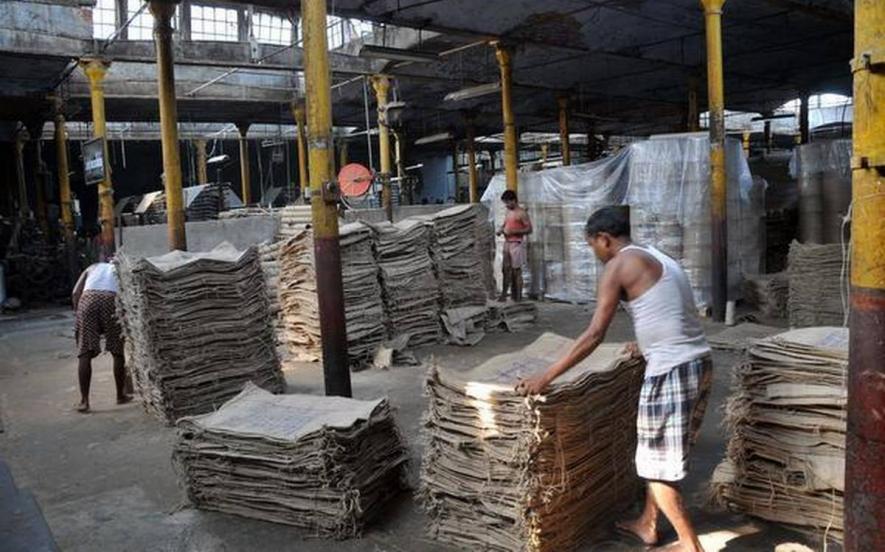Imponderables Mark Start of Jute Year, Rise in Mills’ Capacity Use a Silver Lining

Image for representational use only.Image Courtesy : The Hindu
Kolkata: Although the new jute year 2020-21 started on July 1 as usual, yet even a preliminary, somewhat dependable estimate of the crop size is dicey this time round as supercyclone Amphan and under its influence, incessant, heavy rains in late May caused inundation in the low-lying jute growing districts of West Bengal. The districts are Nadia, North 24 Parganas, and Murshidabad. Assam, which ranks next only to West Bengal as a jute grower, has already had to cope with floods in its jute growing areas in the lower part of the state. The seriously affected districts are Dhubri and Kamrup.
No damage has been reported from the jute growing areas in Bihar, Odisha, and Tripura. But, the damage the crop has suffered in West Bengal and Assam has made a somewhat dependable preliminary estimate of the crop size difficult. Reports collected by the raw jute trade and the mill industry suggest that inundation has stunted the growth of the plants. Which means lengthwise, it will be shorter than usual.
Therefore, the trade and the mill industry have veered round to the view that the crop may be at least 10% lower on estimates made by official agencies when in February-March sowing had made considerable progress. In fact, the reports then collected were considered encouraging and a 15% increase in sowing was found reasonable to assume.
Only by end-August, when harvesting of the crop will have been completed over 90%, reliable figures will be available and what those figures will mean for the estimated 40 lakh people dependent on West Bengal’s jute economy will be known.
Raw jute consumption by the mill industry during the preceding jute year, that is, 2019-20 was by and large according to the estimates till about mid-March when the first signs of disruptive Covid-19 became all too evident, causing widespread panic and forcing the authorities to clamp a lockdown pan-India. Usually, March happens to be the peak production month. Because of the serious disruption that followed and persisted for weeks together, stocks of raw jute at various stocking points increased substantially. The mills were allowed to resume operations only in the course of June, but production initially was nowhere near normal as large sections of financially crippled workers had managed to migrate to their native places in Bihar, UP, Odisha, and some other states.
Considering the ground realities and taking into account the assessment made by the involved official and non-official agencies, the Jute Commissioner’s office had to amend the supply-distribution position for the 2019-20 jute year thus.
The initial assessment for 2019-20 was:
Supply: opening stock 18 lakh bales (lb) plus, crop estimate: 79 lb, import four lb, total 101 lb plus
Distribution: consumption by mills 69 lb, rural/industrial consumption 10 lb, export nil, total 79 lb, closing stock 22 lb plus.
Final estimates for 2019-20:
Supply: opening stock 18 lb plus, crop assessment 68 lb, import four lb, total 90 lb plus
Distribution: mill consumption 54 lb, rural/industrial consumption 10 lb, export nil, total 64 lb, closing stock 26 lb plus What these figures reveal is that there is wide variation under all heads, barring imports.
Also read: COVID-19: Pessimism Pervades Jewellery Trade, Exodus of Karigars Continues
Despite the imponderables, official agencies, the mill industry, and the raw jute traders do make some back-of-the-envelope calculations, taking extra care to see that decisions based on those calculations do not turn out to be wild guesses, say informed quarters.
For the current jute year that began on July 1, before the devastating impact of Amphan became all too evident, the assessment made by the widely representative Jute Advisory Board indicated total supply of 102 lb plus comprising opening stock of 26 lb plus, crop estimate of 72 lb and import of 4 lb.
The assumed distribution break-up showed mill consumption at 65 lb, rural/industrial consumption of 10 lb, export nil; making a total of 75 lb, and leaving the closing stock of 27 lb plus.
In view of the factors already explained, it looks like at this stage that the crop will be lower than assumed 72 lb. Trade sources apprehend a drop of 10% or so. Suspension of operations in the lockdown phase added over 20 lb to the then reckoned inventory. Mills earlier feared that if a shortage of workers due to migration persisted for quite some time, their consumption may at best vary between 52 and 55 lb against the assumed 65 lb. If these figures conveyed the ground reality, the closing stock at the end of 2020-21 would, perhaps, exceed the estimate of 27 lb plus.
But, with mills attaining 80% capacity utilisation lately, showing gradual improvement from 50% and then from 60%, things would appear to be looking up. A good number of workers who had migrated to their native places in the lockdown phase, are back on duty, Sanjay Kajaria, ex-chairman of the Indian Jute Mills Association, told NewsClick.
Keeping in view the Union government’s repeated suggestions to the West Bengal government for allowing resumption of production by the mills in view of the pressing need for B twill bags for packaging the Rabi crop, mills took the initiative to arrange buses for bringing back the workers. Kajaria himself arranged buses to bring back about 350 workers from Bihar, UP, and Odisha, he claimed.
Asked about the size of the new season crop, he said it was too early to put forth a figure. About the likely raw jute price trends, he said justifiable or not, the reality is that in this trade “assumptions matter much more than ground realities and that explains why speculation and stock accumulation often prove to be the determinants”, the former IJMA chairman observed.
Also read: Bengal’s Bid to Expand Kisan Credit Card Coverage Coincides with Centre’s Saturation Drive
“A lengthy chain of middlemen is a fact of life in the raw jute trade,” observed secretary of Jute Balers’ Association, Abhijit Kumar Palit. A host of factors are at work, which often diminish the holding capacity of raw jute farmers for whom the cycle happens to be between two paddy crops, that is, paddy-jute-paddy. Also, with the spread of education and the 100-day job scheme, the family concept long prevalent in this agricultural activity is disintegrating, causing labour shortage. Maize and groundnut farming is also being taken recourse to in anticipation of getting better prices. The area under raw jute was nine lakh hectares a decade back; now it has declined to 5.88 lakh hectares, Palit told NewsClick.
The task of ensuring price stability and safeguarding raw jute growers’ interest rests on the Jute Corporation of India (JCI), which procures 5-7% of the total raw jute output at the predetermined minimum support price (MSP). This may appear quite low if JCI's procurement is to provide price support to growers. But under normal circumstances, mill consumption and consumption in rural areas/other industrial purposes do not show significant fluctuations. Therefore, if this quantity is not reckoned, JCI's price support purchases will account for 20% or so of the balance quantum. It is for the Centre to decide if JCI has to be asked to play a larger price support role, which will warrant augmentation of field staff which in recent years has shrunk, according to trade unions.
For 2020-21, the Centre has increased MSP by Rs 275 to Rs 4,225 per quintal for TDN3 equivalent to TD5 grade (TD stands for Tossa Deshi), according to JCI’s deputy general manager Kalyan Mazumdar. The corresponding MSP for other varieties and grades of raw jute are determined by the Jute Commissioner. The notification dated April 15, 2020, issued by Krishi Bhawan has made it clear that “.....JCI will continue as .... the nodal agency to undertake price support operations, and the losses incurred, if any, ....... will be fully reimbursed ......”.
In the last jute year, MSP was Rs 3,950 per quintal and according to informed quarters the realised price for farmers was in the Rs 4,000-4,300 per quintal range, depending upon when, where, and to whom they sold their produce. Asked whether JCI is equipped to prevent distress sales, Mazumdar told NewsClick: “All I can say is that JCI is keeping a close watch on the evolving situation”.
Also read: COVID-19: ‘Workload of ASHAs Increased, But Incomes Reduced’
Get the latest reports & analysis with people's perspective on Protests, movements & deep analytical videos, discussions of the current affairs in your Telegram app. Subscribe to NewsClick's Telegram channel & get Real-Time updates on stories, as they get published on our website.
























